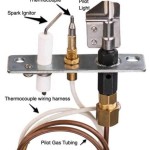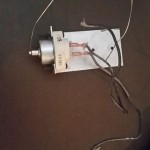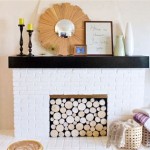Mounting a TV Above a Fireplace Without Studs: A Comprehensive Guide
Mounting a television above a fireplace is a popular aesthetic choice, offering a centralized entertainment hub. However, many homeowners encounter a significant challenge: the absence of readily accessible wall studs in the desired mounting location. Fireplaces often feature brick, stone, or concrete surrounds, or are framed with materials that obscure or lack the standard stud spacing found in typical drywall construction. Successfully mounting a TV in this scenario requires careful planning, the right tools, and a thorough understanding of different mounting techniques.
The absence of studs necessitates alternative anchoring solutions that can effectively distribute the weight of the television across a larger surface area. Simply relying on drywall anchors designed for light loads is insufficient and potentially dangerous. A falling television poses a significant safety hazard and can cause substantial property damage. Therefore, understanding the limitations of different mounting options and choosing the appropriate method for the specific fireplace structure is paramount.
Assessing the Fireplace Structure and TV Weight
The first step in mounting a TV above a fireplace without studs involves a detailed assessment of the fireplace structure. This includes identifying the construction materials of both the fireplace surround and the wall above it. Common materials include brick, stone, concrete, drywall, and wood. Each material requires a specific type of anchor and installation technique. Brick, stone, and concrete are significantly stronger and can support heavier loads, but they require specialized drilling equipment and masonry anchors. Drywall, on the other hand, is weaker and requires more distributed anchoring to compensate for the lack of studs.
The weight of the television is another critical factor. Modern flat-screen TVs can range in weight from relatively light to considerably heavy, depending on their size and screen technology. The chosen mounting hardware must be rated to support at least the weight of the TV, with a safety margin to account for potential vibrations or accidental bumps. Manufacturers typically provide the weight specifications of their TVs in the user manual or on the product packaging. Always consult these specifications before selecting mounting hardware.
Furthermore, consider the size and type of the TV mount. Full-motion mounts, which allow the TV to be tilted and swiveled, exert more stress on the anchoring system than fixed mounts. This is because the leverage created by moving the TV increases the force applied to the wall. For heavier TVs or those using full-motion mounts, a more robust anchoring solution is essential.
Exploring Anchoring Options for Stud-Free Mounting
Several anchoring options are available for mounting a TV above a fireplace without studs. The best choice will depend on the fireplace material and the weight of the TV. One common option is using toggle bolts. Toggle bolts are designed for use in hollow walls, such as drywall, and consist of a bolt and a wing that expands behind the wall to distribute the load. They provide significantly more holding power than standard drywall anchors.
Another option is using heavy-duty drywall anchors. These anchors are specifically designed to support heavier loads in drywall and often feature a ribbed or threaded design for increased gripping power. They typically require a pre-drilled hole and can be installed using a screwdriver or drill. While these anchors offer improved strength compared to standard drywall anchors, they are still not suitable for extremely heavy TVs or full-motion mounts.
For brick, stone, or concrete fireplaces, masonry anchors are necessary. These anchors are designed to grip the hard surfaces of these materials and come in various types, including expansion anchors, sleeve anchors, and wedge anchors. Expansion anchors work by expanding within the drilled hole, creating a tight fit. Sleeve anchors consist of a bolt and a sleeve that expands when the bolt is tightened. Wedge anchors are similar to sleeve anchors but use a wedge-shaped mechanism to provide even greater holding power. Installing masonry anchors requires a hammer drill and appropriate drill bits designed for masonry.
Another less common but potentially viable option is to attach a wooden board to the wall spanning across existing studs and then mount the TV to the board. This requires locating studs to either side of the fireplace but distributes the weight more evenly. The board can be painted to match the wall color or stained to complement the fireplace surround. It’s crucial to select a board of sufficient thickness and width to support the weight of the TV and mount. This option provides a secure mounting surface without directly relying on drywall or masonry anchors in the stud-free area.
Installation Considerations: Safety and Best Practices
Regardless of the chosen anchoring method, safety is paramount during the installation process. Before starting any work, ensure that the power to the outlet near the fireplace is turned off. This prevents electrical shock during drilling and wiring. Use a stud finder to verify the absence of studs in the mounting area and to locate any electrical wiring or plumbing behind the wall. Drilling into these utilities can be extremely dangerous.
When drilling into brick, stone, or concrete, wear safety glasses and a dust mask to protect yourself from flying debris. Use the correct drill bit size for the chosen anchors and drill slowly and steadily to avoid damaging the material. Ensure that the drilled holes are clean and free of dust before inserting the anchors. Tighten the anchors securely, but avoid over-tightening, which can strip the threads or crack the surrounding material.
Before permanently mounting the television, test the stability of the anchors by applying a moderate amount of force to the mount. If the mount feels unstable or the anchors appear to be pulling out of the wall, consider using a different anchoring method or consulting a professional installer. After the TV is mounted, neatly organize the cables and wires to prevent them from dangling or becoming a tripping hazard. Use cable ties or cable management sleeves to bundle the wires and conceal them behind the television.
Professional installation is recommended, especially for heavier televisions or complex mounting situations. Experienced installers have the knowledge, tools, and expertise to safely and securely mount a TV above a fireplace without studs. They can also ensure that the installation complies with local building codes and regulations. While DIY installation can save money, it is important to weigh the risks and benefits carefully before proceeding.

Can I Mount My Tv Above The Fireplace

The Ultimate Guide To Mounting Your Tv Over Fireplace 4 Easy Steps Patriot Chimney

Can I Mount My Tv Above The Fireplace

Mounting A Tv Over Fireplace How Does It Work Echogear

Tv Wall Mount Installation With Wire Concealment Over Fireplace

Never Mount Your Tv Above A Fireplace Here S Why Slashgear

Mount Tv To Wall With No Studs

Tackling My First Mantelmount Mm720 Pull Down Tv Mount Install

Tv Wall Mount Installation With Wire Concealment Over Fireplace
Stud Spacing Above A Fireplace In An Older House What S Going On Diy Home Improvement Forum
Related Posts








